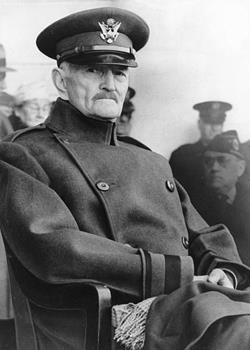About General John J. Pershing

General John J. Pershing may not be as honored as American military heroes Washington, Lee, Grant, and MacArthur, but he was promoted to a rank never obtained before - "General of the Armies.” He had a career spanning from the final frontier wars of the 19th century to his leadership in the Spanish-American War in 1898 to his pursuit of Mexican bandit Pancho Villa in 1916. Pershing is best remembered, of course, for commanding the American Expeditionary Force in the First World War, which helped bring the conflict to a successful conclusion for the Allies.”
John J. "Black Jack" Pershing was the United States' foremost military leader of World War I. His experiences in the Indian Wars, Spanish-American War, the Philippines, Mexican Intervention and the Great War proved his significant contributions to the United States military. Pershing's leadership, organizational skills, dedication to his missions, his men, and his country led to his exceptional military success.
John Joseph Pershing was born in Missouri on 13 September 1860. He attended the State Normal School in Missouri and then taught at a local elementary school. To further his education, he applied and enrolled at the Military Academy at West Point and graduated in 1886. Pershing had never considered military life prior to his admission, but was attracted by the prospect of a first rate education.
Cadet Pershing's excelled in leadership and was awarded the highest class office each year. Graduating in 1886, Pershing was assigned to the Sixth Cavalry Regiment on the Great Plains where he encountered a series of Indian campaigns in New Mexico, Nebraska, and South Dakota. He quickly gained recognition as a tough competent officer.
In 1891 Lieutenant Pershing accepted a position at the University of Nebraska as Professor of Military Science and Tactics. Over the course of four years he transformed the deficient military department into one worthy of comparison to West Point. He also studied for and received his law degree. Pershing was next posted to Montana with a "colored troop," the Buffalo Soldiers of the Tenth Cavalry.
During the Spanish-American War, Pershing fought with the 10th Cavalry in Cuba. He participated in the San Juan Hill operations. Promoted to major of volunteers, Pershing was assigned to Army headquarters and the Office of the Assistant Secretary of War from 1898 to 1899. Pershing reverted to captain in 1901 and served with the 1st and then the 10th Cavalry. Pershing then served in the Philippines as a departmental adjutant general and engineer officer. From 1903 to 1904, he served with War Department General Staff, before attending the Army War College. In 1905, he married Frances Warren, and then was a military observer of the Russo-Japanese War.
President Theodore Roosevelt promoted Pershing to brigadier general over 862 senior-ranking officers in 1906. He successively commanded the Department of California and Fort McKinley. Later, he was assigned to the Office of the Chief of Staff and then served as governor of Moro Province. He commanded the 8th Infantry Brigade at the Presidio of San Francisco from 1914 to 1916.
In 1915, his wife and three daughters were killed in a fire. Only his son, Warren survived after being rescued. After the funeral he returned to Fort Bliss where he turned all of his attention to his work.
In 1916, he led the Punitive Expedition into Mexico and was promoted to major general. In October, 1917, he was made a full general.
When war was declared on Germany in April 1917, John "Black Jack" Pershing was selected to command the American Expeditionary Force (A.E.F.) His task was enormous, to form an efficient working army to join British and French forces in France against Germany. Pershing accepted the challenge. At the time of his appointment there was no expeditionary force available as such; the regular army comprised 25,000 men at most, and no effective reserves. Pershing needed to recruit an organised army and get it into the field; 500,000 men. Eventually the National Army grew - over the period of a year and a half - to nearly 3 million men.
Pershing personally led the successful Meuse-Argonne offensive of 1918.With extraordinary organization, Pershing transferred 600,000 men to northern France in the Meuse-Argonne. A slow advance progressed through the Argonne, until November 11, 1918 when an armistice was declared.
Black Jack Pershing returned to the United States in 1919, where he was hailed as an American hero. He was promoted to a rank never attained before, “General of the Armies.”
Pershing's last position was Chief of Staff. He ended his career working to improve the obstacles he had faced in Europe. Pershing led a reorganization of the Army and created the new General Staff. He established the War Plans Board, urged national preparedness, supported officer schooling, and sought a well-regulated militia He updated military training techniques, emphasized physical training, and started professional schools for officers.
John J. Pershing retired on September 12, 1924 and in 1931, he published his autobiography, “My Experiences in the World War“ which won him the 1932 Pulitzer prize for history.
Pershing never remarried and on July 15, 1948, he died in Washington D.C.
Captain Liddell Hart well articulated the importance of General Pershing to the United States military: "There was perhaps no other man who would, or could have built the American Army on the scale he planned, and without that army the war could hardly have been saved and could not have been won."
Learn more about General John Pershing’s extraordinary career:
http://www.firstworldwar.com/bio/pershing.htm
http://www.nps.gov/tuma/historyculture/general-pershing.htm
